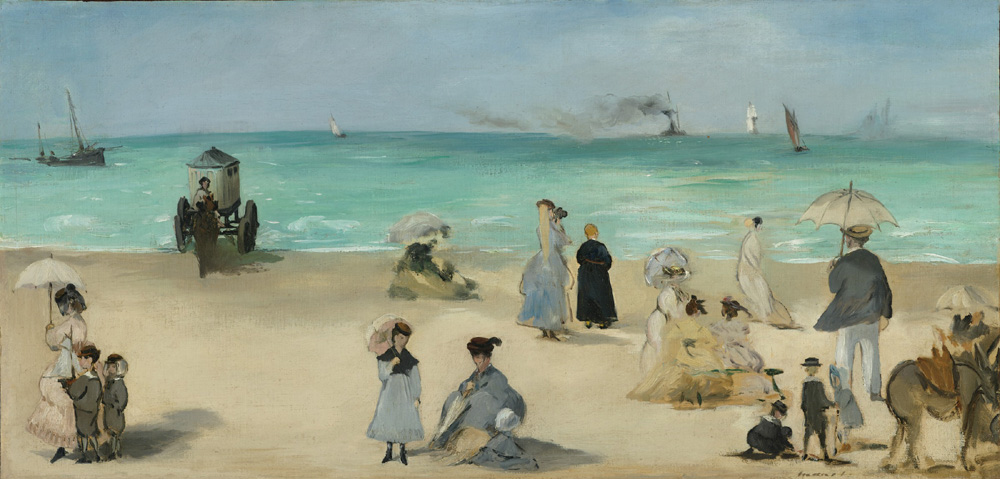By Bruce Suffield
While studying Édouard Manet’s painting, On the Beach, Boulogne-sur-Mer (Accession # 85.498), in the painting conservation studio, it was noted that the artist had used numerous and different brush strokes around one of the compositional elements. He had most likely changed the area around the edges of the bathing machine or bathing cabin. An important compositional subject of this painting, the cabin allowed for beach visitors to change into swimwear, and to let swimmers and waders go into the water beyond the shoreline.
Manet produced numerous sketches in Boulogne of the bathing cabin, certain figural groups, and individual figures that he later used in the painting. Initially the figures in the painting were outlined with fine black to brownish-black brushstrokes. The larger blocks of flat colored areas of the figures were then applied, including black, a color avoided by most other Impressionists. In some areas the still wet outlines were picked up and dragged into adjoining paint, a technique termed wet-in-wet.
In most areas the water and sand passages appeared to come up to the figural groups and stop rather than extend underneath, indicating that the sand and water were applied after the figures were placed and outlined. Another way to describe this technique is to note that the figures were left in reserve. Manet’s painting technique, along with his placement and inconsistent scale of the figures, flattens out the space and challenges our perception of the visual relationship of the figures to one another.


An x-radiograph of the painting was made and revealed that Manet had originally painted the bathing cabin much larger after changing his mind, he then scraped away the cabin paint probably with a palette knife, leaving the scraped area less able to absorb and scatter the x-rays. He adjusted the size of the cabin, making it much smaller, and applied the shorter brushstrokes around it in order to bring the water and sand up to the new shape. While Manet adjusted the much larger bathing cabin, he chose to leave the disproportionate man with an umbrella in the bottom right foreground. The x-radiograph confirms that the composition was well planned in advance by Manet as he arranged the figural groups along the beach scene.
The pigments used in the sand and water contain lead which absorb and scatter x-rays while the figural groups absorb them to a lesser degree, confirming that the figures were placed within the composition before the sand and water passages were applied. Besides lead white pigments in the sand, Manet may have used lead containing true Naples yellow (lead antimonate) as well as tube Naples yellow (chrome yellow, zinc white, and earth). Also visible in the x-radiograph are the stretcher bars and perimeter tacks since they also hinder the passage of x-rays.
Some figures are defined by just a few touches of the brush and others are more completely delineated with detailed brushwork. By composing this work in his studio, Manet expands on how we see the world from how most Impressionist painters thought when they painted out of doors, or plein-air, and directly from their observation of light and color. Manet seems to show us that when we focus on a figure, we see it in detail as peripheral figures become out of focus. We lose perception of scale and depth as our eyes dart along the beach scene from figure to figure. Manet’s painting offers new ways of painting and scaling multiple figures within the same composition that show how we often see the world before us.